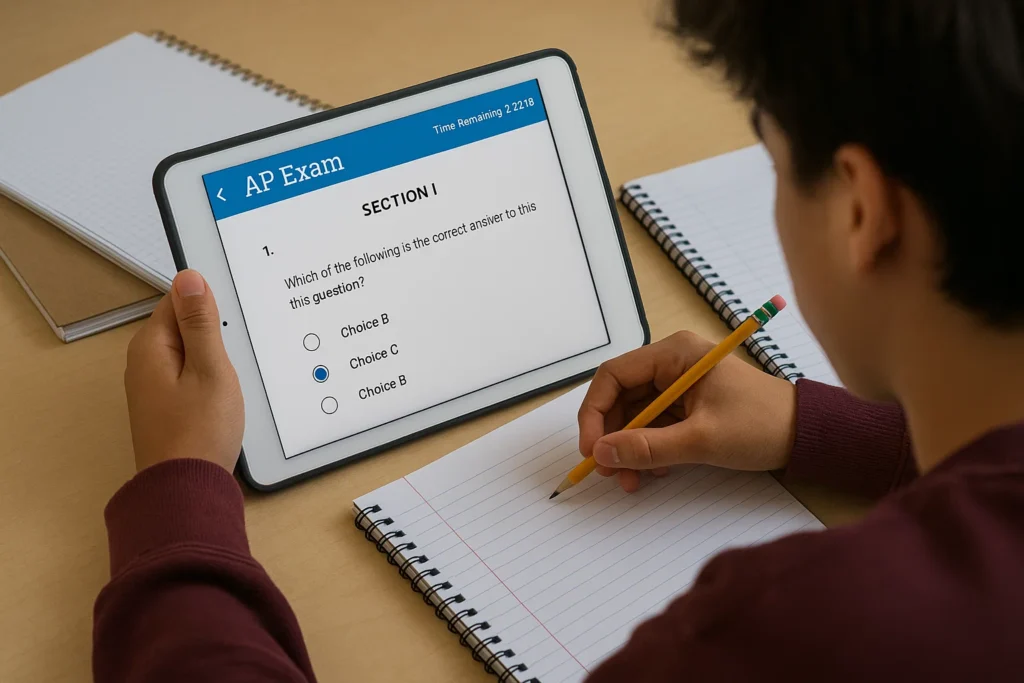Advanced Placement (AP) exams have always challenged high school students to demonstrate college-level mastery, but 2025 brings the biggest changes in decades. The AP program is now shaped by digital innovation, refreshed scoring policies, and rapid shifts in participation. Understanding the new exam formats, how they work, and smart approaches for preparation will set every AP student ahead.
Digital Era: What’s New and Why It Matters
In 2025, most AP exams have transitioned to digital delivery. Out of 40 AP subjects, 28 exams are now fully digital, administered solely on the College Board’s Bluebook app. These include English, history, social sciences, and many language APs. The rest—largely math and science subjects—are hybrid, mixing digital and handwritten elements to preserve essential skills like graphing and notation.
Main Differences: Fully Digital vs Hybrid AP Exam Formats
| Feature | Fully Digital AP Exam | Hybrid AP Exam |
|---|---|---|
| Multiple Choice Questions | Answered digitally in Bluebook | Answered digitally in Bluebook |
| Free Response | Typed digitally in Bluebook | Written by hand in paper booklets |
| Subjects | Humanities, Social Sciences, Languages | Math & Sciences (Calculus, Physics, Bio) |
| Submission | Automatic digital submit | MC auto-submit, FR collected by hand |
| Navigation | Section by section (lock after submit) | MC section digital, FR separate on paper |
| Tools | Digital scratchpad, calculator, annotations | Same, but allows paper diagrams/equations |
Why the hybrid model for some subjects?
Handwritten responses allow students to show their work on graphs, equations, and diagrams naturally—something that’s less practical on screens.
Revised Scoring and Updated Curriculum
The Evidence-Based Standard Setting (EBSS) recalibrates AP scores based on real college benchmarks and faculty feedback, not just historical patterns. This means that a score of 3 or above now more reliably signals true college readiness. Pass rates for some subjects, like AP US History and Biology, have increased in recent years—reflecting curriculum changes and more precise assessment rubrics.
Curricular updates in AP Physics, Government, and other subjects strengthen the alignment between AP and introductory college courses, giving high schoolers a better sense of what lies ahead.
Participation and Satisfaction Trends
2025 sees record-breaking AP participation, with over 6 million exams taken worldwide. The biggest growth is in AP Precalculus, Biology, Seminar, and Government & Politics. Feedback is overwhelmingly positive for digital exams: over 90% of students find the Bluebook app intuitive and satisfaction scores are up in nearly all AP subjects.
Among the highest-rated for student experience: Calculus BC, Government & Politics, European History, Calculus AB, and US History.
Key Strategies for AP Success
For Digital & Hybrid Exams:
-
Practice with sample Bluebook digital exams beforehand.
-
Master both digital test navigation and handwritten responses for hybrid formats.
-
Use features like annotation, flagging, and built-in calculators—get comfortable before exam day!
-
Prepare all needed materials (pencils, admission tickets, calculators) ahead of time.
For Scoring Success:
-
Build a study schedule that prioritizes your toughest APs and distributes workload sensibly.
-
Use official practice tests in timed, exam-like conditions.
-
After each practice, review mistakes closely and adjust your plan.
-
Join study groups and use peer discussion for harder concepts.
Leverage Technology:
AI-powered study tools can personalize your prep: tracking strengths, pinpointing weaknesses, and adapting study content in real time. This makes learning more strategic—and far less overwhelming.
Final Thoughts
The AP landscape in 2025 is dynamic and student-friendly—thanks to digital exams, smarter scoring, and better prep resources. By understanding the differences between fully digital and hybrid formats, adapting to new standards, and prepping with strategy (and tech!), you’ll be ready to earn top scores and unlock college credit.



